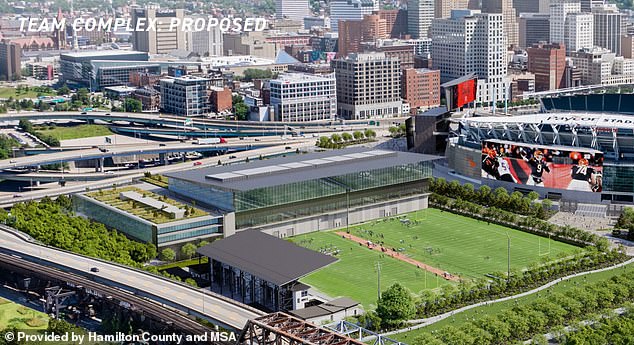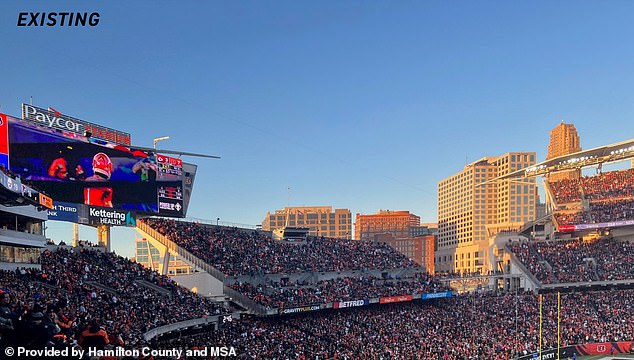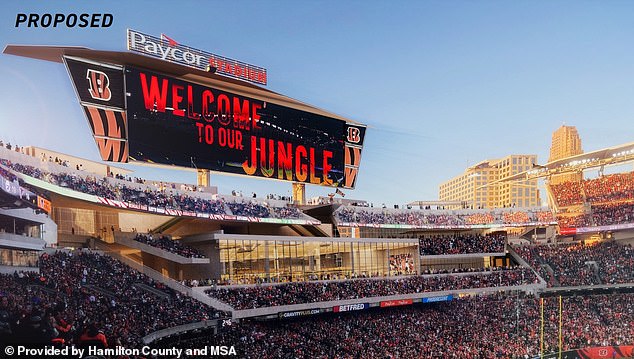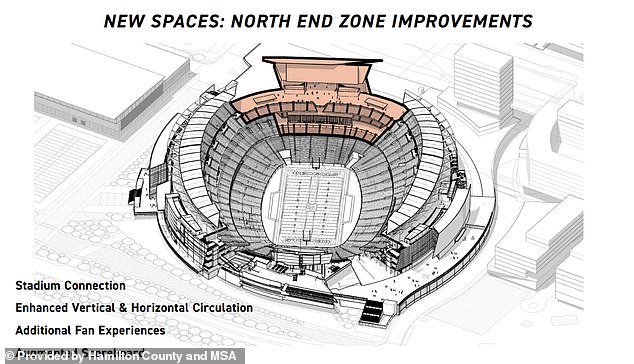Plans for Cincinnati Bengals’ $1.2b stadium renovations are revealed… but financing remains a mystery with team’s lease set to expire in 2026
Officials in Hamilton County, Ohio, announced plans for a $1.2 billion renovation of Paycor Stadium, home of the Cincinnati Bengals.
With the team’s lease expiring in 2026, local government is trying to ensure the club, founded in 1968 by Hall of Famer Paul Brown, remains in the Queen City for the foreseeable future.
The problem is that the team’s 25-year-old Paycor Stadium (formerly Paul Brown Stadium) is now seen as ill-equipped for an NFL franchise. And with a new stadium likely to cost more than $5 billion to build, the county is hoping renovation plans from architectural firm MSA Sport will suffice.
Unfortunately, the financing is still unclear.
There are currently no new taxes proposed to fund the renovation plans, although an existing half-cent sales tax remains on the books from a quarter century earlier when the stadium was first funded.
The Bengals currently practice near a concrete plant along the Ohio River

County officials hope to move the concrete plant downstream to build a practice facility
That existing tax, along with team and league contributions, may be needed to get the proposal across the proverbial goal line. Hamilton County Commissioner Alicia Reece wants $100 million from the NFL and has criticized the current team-friendly lease as a burden on taxpayers.
“My goal is to have a diversified plan,” Reece said in 2023, as quoted by Cincinnati.com. ‘Everybody’s watching. NFL, you stick your neck out for other teams. You’ve got to stick your neck out for our team. Give us some respect.’
According to Cincinnati.com, the Bengals have the right to extend the current lease for either five or two years.
According to Hamilton County officials, the proposed renovations will result in a 35 percent increase in stadium floor space, 67 percent more entrances, 38 percent more fan amenities, 20 percent more restrooms and a 17 percent increase in concessions.

The north end zone will see the biggest change if the MSA Design plans are adopted

And as with all stadium renovations, there would be a massive scoreboard upgrade

A rendering of the plans for the north end zone of Paycor Stadium can be seen

Naturally, new concessions will be opened as part of the proposed renovations at Paycor
An important part of the plans is the renovation of the practice room.
Currently, the Bengals use an indoor practice facility and surrounding fields adjacent to a concrete plant along the Ohio River.
The proposal provides for a larger physical facility with indoor and outdoor practice fields.
If the proposal is passed, Paycor’s total capacity would remain around 65,000 seats, but with a higher percentage of club seating.
Many of the surrounding streets and walkways would be reconfigured to create more open space along the river while making the stadium more accessible to all fans.
And as with all stadium renovations, there would be a massive scoreboard upgrade. In this case, a new 200-foot wide, 60-foot tall scoreboard would be added to the north end zone at Paycor.
The Bengals originally played two seasons at Nippert Stadium, where the University of Cincinnati still plays football. They moved to Riverfront Stadium in 1970 and enjoyed two AFC titles while playing at the multi-sport facility.
